Courtesy of a police car’s camera…pretty cool, I haven’t seen anything like this before on video or in person…
Technology & Science
Meteor over Edmonton
Business, Innovation
Detroit Dilemma
This week has been stunningly busy, meaning I found it difficult to keep up with first-order responsibilities, let alone first-order obsessions like blogging. Things are starting to lighten up a bit now and I expect to get back to a more regular rhythm of publishing.
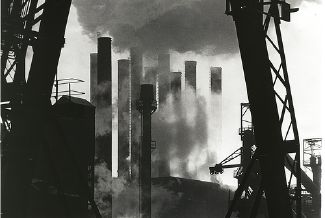
One of the events I’ve been dying to comment upon is the mess in Detroit. The injury is 100% self-inflicted; here is some evidence: Ford won’t sell 65 mpg vehicle in the US.
Yes, the economy is bad. People are still buying things they need and value. What Detroit (as a proxy for GM, Ford, and Chrysler) needs to understand is that consumers neither need nor value their product. That means when the economy turns down, as a discretionary purchase, sales will plummet even more dramatically than their competitors.
Much attention is being paid to cost structure and practices of the auto manufacturers, yes, those need some work. But the crux of the matter is, US manufacturers aren’t producing products the consumer needs and values. Without solving that problem, the cost structure matters only in that it prolongs the slow and painful death of the industry.
Core to this whole situation is a mindset and attitude. While I don’t particularly think the grandstanding around “How did you get to this hearing? In a private jet?” is useful or particularly relevant to the core facts, it is a symptom of a deeper problem.
Imagine that you would like to secure a large sum of money from potential investors, say a $25B loan. Now, imagine that you’re going to be in a public setting where the decision makers will hear the relative merits of the case to provide you the funding. Now, imagine that you show up and your core argument is “I need the money so I don’t go broke – and you don’t want me to go broke because it will affect 10x as many people as just me.” There’s a certain hubris in that assumption that money will be handed over simply because you need it.
As a decision maker for a loan or investment, I’d like to know how the money will be used to create a viable, competitive, and sustainable business that will benefit 10x the number of people who receive the direct funding. Can you imagine any other business going to request money, having flown in on private jets, without any apparent business plan? What’s even more disturbing in some ways is once challenged about the lack of such a plan, they agreed to come back in a couple of weeks with one. If it is so easy to do, why didn’t they come armed in the first place?
This tells me we’ve got a bunch of chuckleheads running Detroit. At least on the Wall Street meltdown there was an investment and return thesis, however flawed it appears to have been in hindsight. These jokers have an attitude of entitlement, are risk averse, and don’t even understand core business tenets sufficiently to know that you show up looking for funding with a business plan!
As much as it hurts to type this sentence, I’m going to follow through. Detroit needs to die. The current instantiation of the auto industry cannot be evolved to the new footing that is required to be competitive in the 21st century. I hope that from the ashes a more responsive, customer-centered, business minded, set of leaders who have the chutzpah to take calculated risk. We shouldn’t fund their continued deterioration. If there’s a compelling business case that can take advantage of their infrastructure, workforce, and brands, then we should consider funding it – provided new, non-chucklehead leadership will take it forward.
Business, Energy, Innovation
Chrysler Challenge (repost)
On April 7, 2007 I wrote this entry, given the news out of Detroit, I thought I’d dust it off and post it again. Mr. Kerkorian did not buy Chrysler, and I bet he’s happy.
Earlier this week there was news that Kirk Kerkorian made a $4.5B cash bid for Chrysler. Must be nice to have that much change lying around…
But to get to the point of this post, it is Easter weekend and for a couple of billion people around the globe, that means celebrating the resurrection of Jesus (or, something to do with rabbits laying colorful eggs and various chocolate treats.) But I digress. Let’s assume Kerkorian gets Chrysler from the good folks at Daimler, what should he do with it?
Like all American auto makers, it has a fleet of non-competitive vehicles, which coupled with rising fuel costs, is simply hammering sales. I snagged the graph below from the film An Inconvenient Truth, unfortunately, Chrysler’s market cap wasn’t on the slide since it is a subsidiary company.
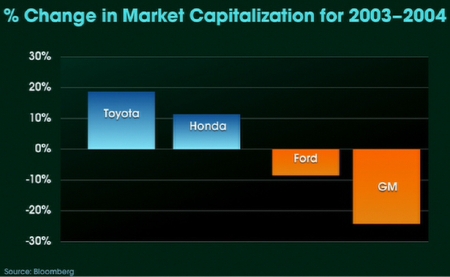
It doesn’t take a Wall Street expert to interpret this chart. Fuel efficient vehicles are winning, and winning big. Last week, Toyota announced that it sold 28,453 hybrid vehicles in March. More than all of Saturn, GM’s fastest growing brand. This is not a temporary shift, it is permanent, inexorable, and accelerating.
As Easter suggests, sometimes things need to die before they can be resurrected and come back even stronger. I think that’s where the US Auto Industry is, it’s clearly dying because it is incapable of change.
Mr. Kerkorian, here’s the challenge: Don’t use half-measures, don’t compromise with hybrids. Crucify the gasoline and diesel engine. The 640hp Electric Mini project has already proved this is possible. Take the bold step forward to launch the following all electric vehicles from Chrysler:
- Full-sized pickup
- 4 door sedan
- Minivan
- Station wagon
- Coupe
Don’t get cute with this stuff, no distinctive designs, no hybrid systems, keep the range over 250 miles (400km,) and engineer the systems to use 4 motors, one on each wheel. Use your existing designs, rip the combustion engines, emissions equipment, and transmissions out and replace them with deep cycle batteries, 4 wheel mounted motors, and a 100 foot (30m) retractable extension cord. Engineer the power system to have the right performance characteristics: i.e., good low-end torque on the truck and fast acceleration on the passenger vehicles.
Get to market next year. It’s possible. What do you lose? The old market. The long haul market. But, do you care? Chrysler has lost, or is rapidly losing those markets anyway. Use your brand, your dealer network, and your manufacturing and distribution infrastructure to make this happen and to make it happen fast. And if Chrysler ultimately dies as a result of this decision? At least it went out swinging. And hey, you’re worth $15B now, you’ve still got $10B left.
This is not the time for half-measures, it’s the time for bold leadership. We’re closing factories and shipping work offshore, we’re sending billions into the middle east to fund terror each time we fill our gas tank, the temperature of the earth is quickly rising as a result of greenhouse gases. We’re facing a crisis on multiple dimensions.
Mr. Kerkorian, when you bought those surplus World War II bombers you took an enormous risk. When you built the original MGM Grand Casino, at the time, the world’s largest hotel, you took an enormous risk. You’ve got a track record, you’ve got the cash, you can do this.
The question is, will you?
Coastal Stuff
Lady Washington is in the Harbor
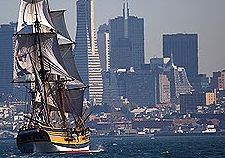
Today my daughter and I made the short trip to Pillar Point Harbor to visit the Lady Washington, a 112 foot long brig armed with 4 cannons and equipped with 6 miles of rigging (see images below…) We handed over a few bucks as a donation and proceeded to board via a gangplank grafted to the side of the ship.
The new Lady Washington is a full-scale reproduction of the original Lady Washington. Built in the British Colony of Massachusetts in the 1750’s, the original vessel carried freight between colonial ports until the American Revolutionary War, when she became an American privateer. In 1787, after the war, she was given a major refit to prepare her for a unprecedented trading voyage around Cape Horn. In 1788, she became the first American vessel to make landfall on the west coast of North America.
A pioneer in Pan-Pacific trade, she was the first American ship to visit Honolulu, Hong Kong and Japan. Lady Washington opened the black pearl and sandalwood trade between Hawaii and the Orient when King Kamehameha became a partner in the ship.
The modern Lady Washington was thoroughly researched by historians and constructed by skilled shipwrights. She was launched as part of the 1989 Washington State Centennial celebration. The new Lady Washington meets all of the U.S. Coast Guard safety requirements for a 21st–century ship.
Despite being a reproduction, it gave a very clear view about what life aboard such a ship would be like (minus the diesel fumes.) It was very cool – when queried about the desire for a trip around the harbor aboard, my daughter didn’t think it was a good idea. So we saved big bucks based upon her preference. (Though I have to admit, I wouldn’t have minded spending a few hours aboard sailing…)
After the tour of the ship, we hung around the harbor and watched crab pots being loaded in the crab boats getting ready for the season. There was part of the bridge of the boat Irene left dockside, my daughter had a blast playing inside there turning the wheel pretending to be at sea fighting through imaginary storms. There was a little aquatic bird fishing in the harbor, this was also high fun.
Even more interesting than the Lady Washington was the notion that sea life (barnacles and the like) attach themselves to the bottoms of boats; the quote was “Papa, why are the bottoms of the boats fuzzy?” Finally, we watched a harbor seal at play and called it a day. Fun was had by all. The Lady Washington will be in port through next weekend.
More photos from our visit are below:
Ship’s Bell and one of the masts with rigging
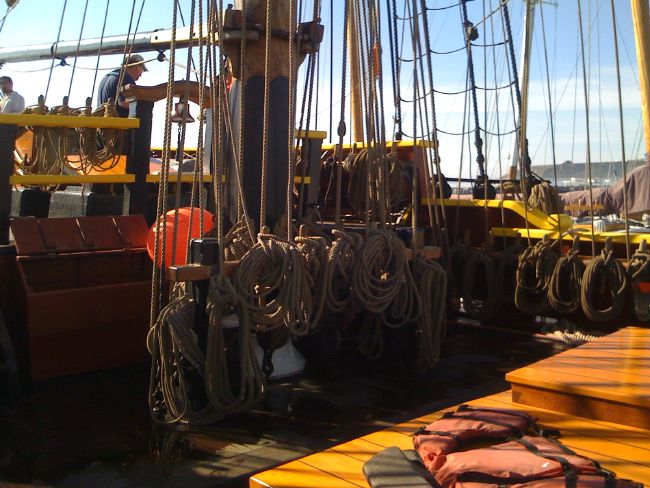
Sails and rigging on one of the two masts
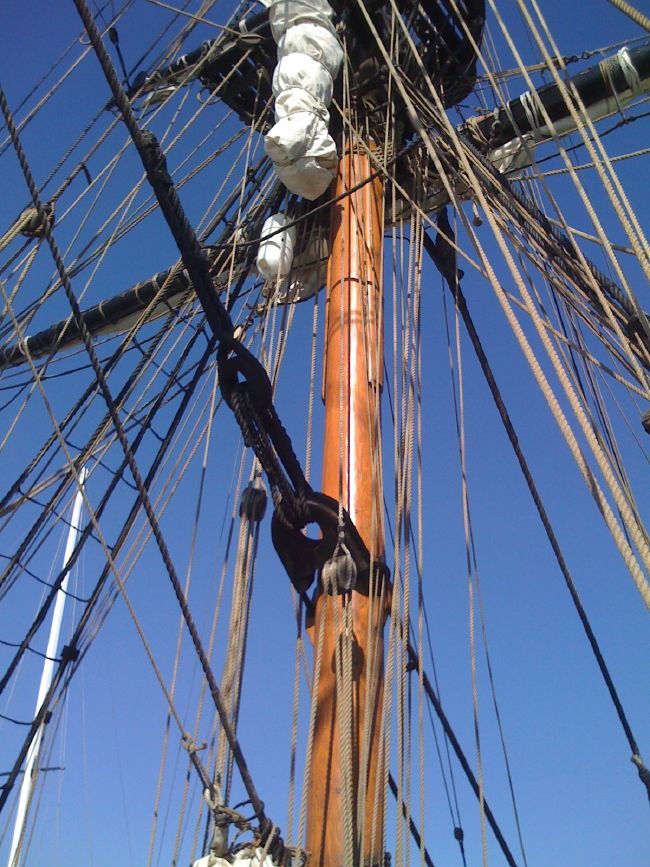
Flag, Rigging, and the other mast
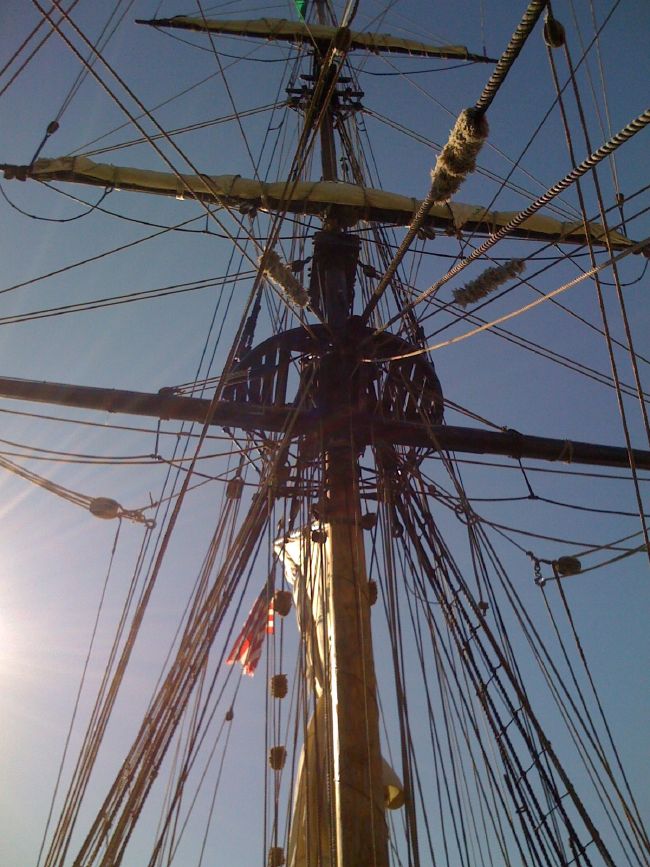
View of the Lady Washington from the Main Pier

Coastal Stuff
Fantastic Fajitas
Yesterday, the mercury touched 80F (27C) in an unprecedented, late taste of summer. The coast was overrun by tourists and the beaches were swamped. But it did bring one of the best perks for a great weekend here which is the thrill of grilling. For several years I’ve been working to perfect an authentic fajita taste experimenting with the meat, the heat, the marinate, and the dry rub. Yesterday, I think the code was cracked (and according to my family’s reaction, I’ll go with, it was cracked.)
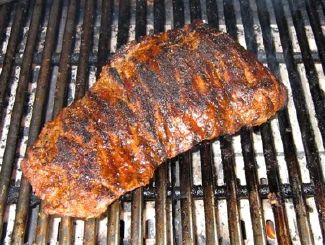
So, in the spirit of full disclosure, I share with you the best tasting way I’ve yet discovered to make fajitas on the grill. It’s simple, it’s cheap, and it tastes great.
Job 1, get good ingredients. Start with skirt steak, it’s cheap though not commonly available – the local butcher is a better bet than the big-box grocery store. Fresher is better. The kicker? It’s cheap, $1.99/lb. You’ll want to get two steaks each 0.75 to 1 lb each. Trim any fat from the meat and take the membrane off the back side.
Job 2, prepare the marinate, one beer (12 oz,) the juice of one orange, the juice of three limes, and two tablespoons of worcestershire sauce. Combine ingredients in a 1 gallon ziplock bag, drop the meat in, let it cold marinate (in the fridge) for a minimum of three hours and a max of 24 hours before you plan to grill.
Job 3, prepare the dry rub. Combine 1 tablespoon of chili powder, 1 tablespoon of coarse salt (like a sea salt or kosher salt,) 1 tablespoon of brown sugar, and 1.5 teaspoons of cumin. (optional, if you have a desire for hot and spicy, a teaspoon of cayenne pepper does the trick.)
Job 3, prepare to grill. 30 minutes before you plan to grill, drain the marinate from the meat, dry the surface of the meat. Spread the dry rub on the meat in an even, light coat. Let it sit at room temperature until you’re ready to go.
Job 4, grilling. Bring your grill to high temperature, cook uncovered for 5-6 minutes per side to get a medium result, reduce the time for medium-rare/rare, increase the time for medium-well/well (which I don’t recommend for good fajitas – medium is just fine.) Turn frequently – whenever juice appears on the surface – a minimum of five times (you’re looking for 11-12 minutes total cook time.)
Job 5, prepare and eat. When the grilling is finished, slice the meat across the grain into finger-sized lengths. Serve with avocado and warmed flour tortillas. Chips and salsa as sides. And Corona beer with lime slices. Dee-lish!
If you try it, let me know how it turns out. Hope your experience is a good one. Happy grilling!
« Previous Entries
» Next Entries



